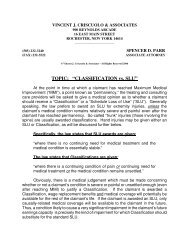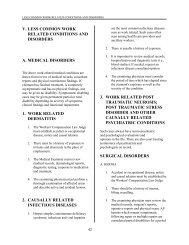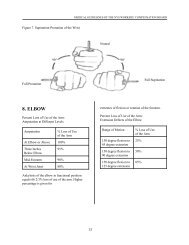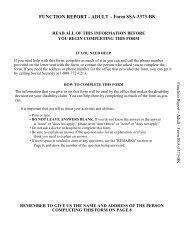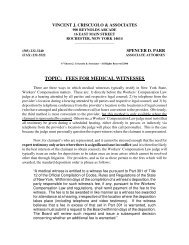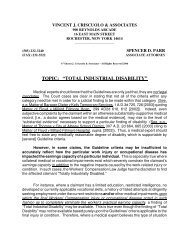Loss of Vision
Loss of Vision
Loss of Vision
Create successful ePaper yourself
Turn your PDF publications into a flip-book with our unique Google optimized e-Paper software.
VISUAL SYSTEM<br />
VII. VISUAL SYSTEM<br />
INTRODUCTION<br />
The purpose <strong>of</strong> this chapter is to provide criteria<br />
for use in evaluating permanent impairment<br />
resulting from dysfunction <strong>of</strong> the visual system,<br />
which consists <strong>of</strong> the eyes, ocular adnexa and the<br />
visual pathways. A method is provided for<br />
quantitating visual impairment resulting from a<br />
work-related injury. This can then be translated<br />
into a payment schedule.<br />
The parameters for scheduling are: (1) loss <strong>of</strong><br />
uncorrected or corrected visual acuity for objects<br />
at distance, (2) visual field loss and (3) diplopia.<br />
Evaluation <strong>of</strong> visual impairment is based on these<br />
three functions. Although they are not equally<br />
important, vision is imperfect without the<br />
coordinated function <strong>of</strong> all three.<br />
Where there is a visible deformity related to the<br />
eye and face, this is scheduled on a per case basis.<br />
The following equipment is necessary to test the<br />
functions <strong>of</strong> the eye:<br />
1. Visual acuity test charts for distance vision;<br />
the Snellen test chart with letters<br />
50<br />
and numbers, the illiterate E chart, or<br />
Landolt's broken-ring chart is desirable.<br />
2. Either a Goldmann type or automated<br />
perimeter where the extent <strong>of</strong> visual field is<br />
recorded in degrees.<br />
3. Refraction equipment or report <strong>of</strong> a recent<br />
refraction or recently prescribed glasses.<br />
4. A hand held light with a red glass.<br />
5. A slit lamp.<br />
6. An ophthalmoscope.<br />
A. CRITERIA AND METHODS<br />
FOR EVALUATING<br />
PERMANENT IMPAIRMENT<br />
1. CENTRAL VISUAL ACUITY<br />
The chart or reflecting surface should not be dirty<br />
or discolored. The far test distance simulates<br />
infinity at 6 m (20 ft.) or at no less than 4 m (13<br />
ft. 1 in.).<br />
The central vision should be measured and<br />
recorded for distance with and without wearing<br />
conventional spectacles. The use <strong>of</strong> contact lens<br />
may further improve vision reduced by irregular<br />
astigmatism due to corneal injury or disease. In<br />
the absence <strong>of</strong> contraindications, if the patient is<br />
well adapted to contact lenses and wishes to wear<br />
them, correction by contact lenses is acceptable.<br />
Visual acuity for distance should be recorded in<br />
the Snellen notation, using a fraction, in which the<br />
numerator is the test distance in feet or meters,<br />
and the denominator is the distance at which the<br />
smallest letter discriminated by the patient would<br />
subtend 5 minutes <strong>of</strong> arc, that is, the distance at<br />
which an eye with 20/20 vision would see that<br />
letter. The fraction notation is one <strong>of</strong> convenience<br />
that does not imply percentage <strong>of</strong> visual acuity.
The Procedure for determining the loss <strong>of</strong><br />
central vision in one eye is as follows:<br />
(1) Measure and record best central visual<br />
acuity for distance with and without<br />
conventional corrective spectacles or contact<br />
lens.<br />
(2) Schedule according to the Table 1 for<br />
uncorrected or corrected visual loss (in<br />
the injured eye) whichever is greater.<br />
TABLE 1<br />
SCHEDULE VISUAL LOSS<br />
Visual Acuity Schedule %<br />
20/20 0<br />
20/20-1 5<br />
20/20-2 7 1/2<br />
20/20-3 10<br />
20/20-4 15<br />
20/25 20<br />
20/25-1 22 1/2<br />
MEDICAL GUIDELINES OF THE NYS WORKERS’ COMPENSATION BOARD<br />
51<br />
20/25-2 25<br />
20/30 33 1/3<br />
20/30-1 35<br />
20/30-2 37 1/2<br />
20/30+1 30<br />
20/30+2 or 3 27 1/2<br />
20/40 50<br />
20/40+2 45<br />
20/40+3 40<br />
20/40-1 or 2 52 1/2<br />
20/40-3 55<br />
20/50 60<br />
20/60 65<br />
20/70 70<br />
20/70-1 or 20/70-2 75<br />
Over 75% give 100%<br />
2. VISUAL FIELDS<br />
The extent <strong>of</strong> the visual field is determined by<br />
using a perimetric method with a white target. If<br />
the Goldmann 30 cm. radius bowl perimeter is<br />
used, the III/4 e target in the kinetic mode should<br />
be employed.<br />
3. DETERMINING LOSS OF<br />
VISUAL FIELD<br />
The following steps are taken to determine the<br />
loss <strong>of</strong> visual field:<br />
(1) Plot the extent <strong>of</strong> the visual field on each<br />
<strong>of</strong> the eight principal meridians <strong>of</strong> a<br />
visual field chart (Figure 13).<br />
(2) Determine the percentage loss to schedule<br />
according to Table II.
VISUAL SYSTEM<br />
4. DETERMINING SCHEDULE FOR<br />
DIPLOPIA<br />
Do red glass test, charting magnitude <strong>of</strong> diplopia<br />
within 30 degree field and calculate according to<br />
Table III. Schedule to loss for the injured eye.<br />
Combine the percentage loss for diplopia with the<br />
schedule for central vision loss and visual field<br />
loss in the injured eye.<br />
TABLE II<br />
VISUAL FIELD LOSS<br />
<strong>Loss</strong> <strong>of</strong> Schedule-One Eye %<br />
Upper 33 1/3<br />
1/2 <strong>of</strong> Upper 16 2/3<br />
Lower 66 2/3<br />
1/2 <strong>of</strong> Lower 33 1/3<br />
Also: Sum <strong>of</strong> 8 principal radii <strong>of</strong> peripheral field<br />
total 420. This is 100% industrial visual field<br />
efficiency.<br />
Figure 13. Example <strong>of</strong> Perimetric Charts.<br />
52<br />
To calculate: Add 8 principal meridians <strong>of</strong><br />
patient’s peripheral field (x)<br />
x<br />
-- = % Efficiency (y)<br />
420<br />
100 - y% = % <strong>Loss</strong> to schedule for eye<br />
TABLE III<br />
DIPLOPIA<br />
Consider for 30 degree field<br />
Diplopia In Schedule-One-Eye%<br />
Entire Upper Field 33 1/3<br />
Half <strong>of</strong> Upper 16 2/3<br />
Field<br />
Entire Lower 66 2/3<br />
Field<br />
Half <strong>of</strong> Lower 33 1/3<br />
Field<br />
Note: Charts used to plot extent or outline <strong>of</strong> visual field along the eight principal meridians<br />
that are separated by 45 degree intervals.<br />
LEFT EYE RIGHT EYE<br />
Note: Charts used to plot extent or outline <strong>of</strong> visual field along the eight principal meridians that are<br />
separated by 45 degree intervals.





